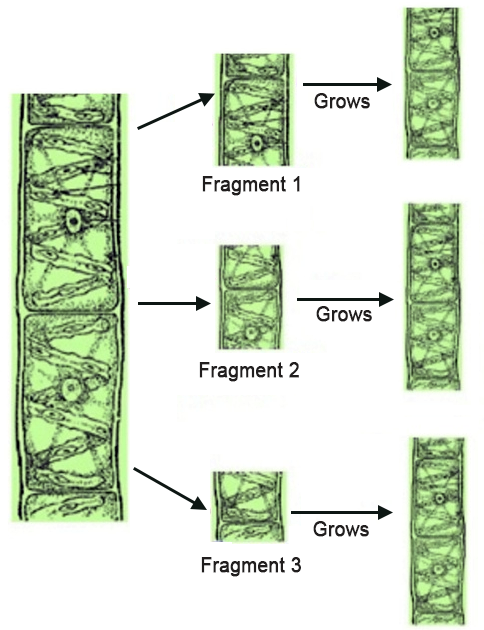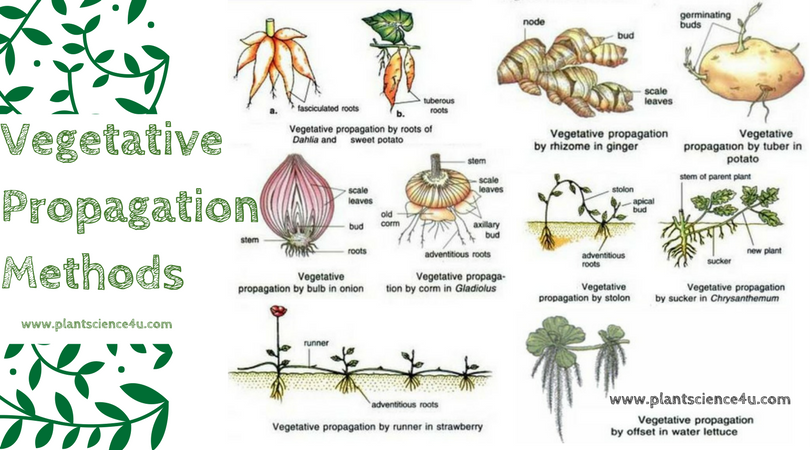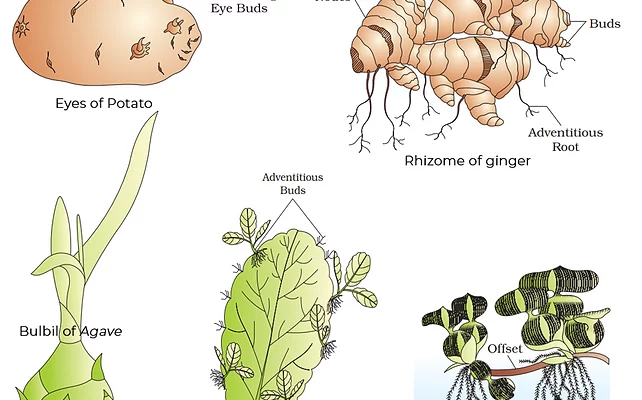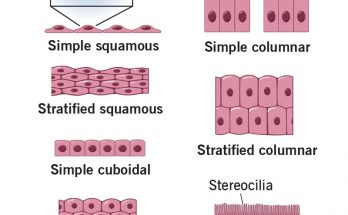Asexual Reproduction is a fascinating way plants make new plants exactly like themselves without needing seeds! This method of making new plants without the use of seeds or any form of sexual processes.
What is Asexual Reproduction?
Asexual reproduction is like plant cloning! Imagine if you could make an exact copy of yourself; plants do just that. They create new plants with the same characteristics, and these new plants are like twin siblings because they have the same genetic information.
Different Ways Plants Reproduce Asexually
Asexual reproduction in plants means they make copies of themselves without using seeds. Let’s dive into the many ways plants do this-
Budding
What is it?
Budding is a process where a new plant grows out of a small part (a bud) on the parent plant. Think of it like a tiny plant starting on the side of a bigger one, then slowly growing until it’s ready to live on its own.

Example
Yeasts, which are used to make bread and pizza dough rise, reproduce by budding. A yeast cell grows a bump that gets bigger and eventually splits off to become a new yeast cell.
Fragmentation
What is it?
Fragmentation occurs when a piece of the plant breaks off, and this piece is capable of growing into a new plant. It’s as if you could take a piece of your hair and plant it to grow a new you!

Example
Spirogyra, a slimy green algae you might see in ponds, can break into pieces, and each piece can become a new algae strand.
Vegetative Propagation
What is it?
This is when parts of a plant like roots, stems, or leaves grow into a new plant. It’s kind of like how you can take a cutting from a plant and put it in water or soil to grow a new one.

Example
- Roots: Sweet potatoes have buds on their roots that can grow into new sweet potato plants.
- Stems: When you plant a stem of sugarcane or ginger, it can sprout and become a new plant.
- Leaves: The plant called Bryophyllum has leaves that, if they fall on the soil, will grow baby plants right on the edge of the leaf.
Also Check – Vegetative Propagation- A Detailed Exploration for Young Learners
Spore Formation
What is it?
Spore formation is when plants produce tiny cells called spores, which can grow into new plants under the right conditions. Spores are like seeds but much simpler and usually smaller.

Example
When bread gets moldy, that’s a fungus growing. Fungi, like molds, make spores that float away and start new molds when they land in a good spot.
Eyes
What is it?
The ‘eyes’ of a plant are growth points which can sprout and grow into new plants. These aren’t eyes like animals have; they are spots on a plant that can grow into new ones.

Example
Potato ‘eyes’ are little buds that can grow into new potato plants. If you plant a potato in the soil, these eyes will sprout into new plants.
Why do Plants Choose Asexual Reproduction?
Plants are very smart in their own way. They always try to find the best method to make more plants and keep surviving. Sometimes, plants choose asexual reproduction as their method to make more plants. But why do they do that? Let’s find out!
- Quick Process-
- Plants can make more of themselves faster through asexual reproduction. It’s like magic; one plant can quickly become two, three, or even more without waiting for seeds to grow.
- No Need for a Partner-
- In asexual reproduction, a plant doesn’t need a partner to make a new plant. It’s a solo act! This means that even if there are no other plants nearby, a single plant can still make more plants on its own.
- Making Exact Copies-
- Plants that reproduce asexually create exact copies, or “clones,” of themselves. This is a great way for them to keep all their good qualities in the new plants.
- Surviving Tough Conditions-
- Asexual reproduction can be very helpful in places where the environment is tough. Since plants can reproduce by themselves, they can keep growing and surviving even in difficult conditions.
- Spreading in the Area-
- Because it’s a faster way of reproducing, asexual reproduction helps plants spread quickly in the area where they are growing. This way, they can cover more ground and make the most out of the resources around them.
Also Check – 12 Difference between Sexual and Asexual Reproduction
Where Does Asexual Reproduction Occur?
Have you ever wondered where plants can do this amazing trick of making more of themselves without using seeds? Let’s take a journey to discover the places and parts of plants where asexual reproduction happens!
- Stems Above the Ground-
- Some plants have special stems above the ground that grow sideways. These stems can create new plants! A common plant you might know that does this is the strawberry. Ever noticed how strawberry plants spread out and create baby plants attached by long stems? That’s asexual reproduction in action!
- Underground Stems-
- Not all magic happens where we can see it. Some plants grow stems below the soil, hidden from our eyes. These stems can grow new plants from them. Have you ever eaten a potato? The potato we eat is actually an underground stem that can sprout and become a new plant!
- Leaves-
- Yes, you read that right! Some plants can make baby plants from their leaves. A plant called Bryophyllum has tiny plantlets growing at the edges of its leaves. If a leaf falls on the ground, these tiny plantlets can grow into full-sized plants.
- Buds-
- Some plants, like the yeast used in making bread, form little bubbles or “buds” on them. These buds grow and eventually separate to become new plants or organisms.
- Water-
- Plants living in water, like the algae called Spirogyra, can also reproduce asexually. They break into small pieces, and each piece grows into a new plant. Imagine breaking a pencil and each piece becoming a new pencil – that’s how these plants work!
Questions You Might Have
Q- How is asexual reproduction different from sexual reproduction?
A- Asexual reproduction involves one parent and produces offspring that are genetically identical to the parent. In contrast, sexual reproduction involves two parents, and the offspring have mixed traits from both parents.
Q- Why don’t all plants reproduce asexually?
A- While asexual reproduction is efficient and quick, sexual reproduction brings genetic diversity, which helps plants adapt to changing environments and survive different challenges.
Q- Can a plant reproduce both sexually and asexually?
A- Yes, many plants have the ability to reproduce both ways. They can produce seeds (sexual reproduction) and also reproduce through methods like budding or vegetative propagation (asexual reproduction).
Q- Are spores the same as seeds?
A- No, spores are different from seeds. Spores are single cells protected by a thick wall, while seeds contain a plant embryo and stored food surrounded by a protective coat.
Conclusion
Asexual reproduction in plants is like nature’s shortcut to making new plants. It’s simple, efficient, and ensures the continuation of a plant’s legacy with all its wonderful characteristics. Isn’t it amazing how plants have such smart ways to create new life?
Also Check – Rapid Revision – Class 7 Science- Chapter 12 – Reproduction in Plants
Also Check – Class 7 Science- Chapter 12 – Reproduction in Plants- (Complete Notes)
Also Check – Class 7 – Science- Chapter 12 – Reproduction in Plants question answer (Long Question Answer)
Also Check – Class 7 – Science- Chapter 12 – Reproduction in Plants question answer (Short Question Answer)
Also Check – Chapter 12 – Reproduction in Plants–Class 7 science- Question and Answer (Solved MCQs)
Also Check – Chapter 12 – Reproduction in Plants-–Class 7 science- Question and Answer (Fill in the Blanks)
Also Check – Asexual Reproduction Basics – Simplified for Young Learners
Also Check – NCERT Solutions for Class 7 Science Chapter 12-Reproduction in Plants

